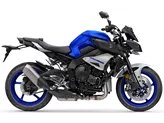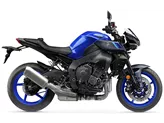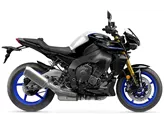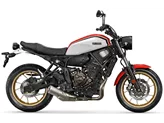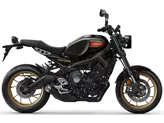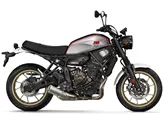Yamaha XSR900 2018 vs. Yamaha MT-10 2017

Yamaha XSR900 2018

Yamaha MT-10 2017
Overview - Yamaha XSR900 2018 vs Yamaha MT-10 2017
The Yamaha XSR900 2018 and the Yamaha MT-10 2017 are both naked bikes with similar engine types, in-line configurations, and liquid cooling systems. However, there are several notable differences between the two models.
In terms of engine power, the Yamaha MT-10 2017 outperforms the XSR900 2018 with 160 HP compared to 115 HP. Similarly, the MT-10 has a higher torque of 111 Nm compared to the XSR900's 87.5 Nm. This difference in power and torque is due to the MT-10 having four cylinders while the XSR900 has three.
Both bikes feature upside-down telescopic forks for the front suspension and swing arms with monoshock absorbers for the rear suspension. The chassis of both models is made of aluminum, but the XSR900 has a twin-tube frame while the MT-10 has a Deltabox frame.

Yamaha XSR900 2018
In terms of braking, both bikes have double disk brakes at the front, but the MT-10 has larger diameter disks at 320 mm compared to the XSR900's 298 mm. Both models also feature ABS as an advanced rider assistance system.
The dimensions and weights of the two bikes also differ slightly. The XSR900 has a smaller fuel tank capacity of 14 liters compared to the MT-10's 17 liters. The XSR900 has a wheelbase of 1440 mm, while the MT-10 has a slightly shorter wheelbase of 1400 mm. The seat height of the XSR900 is 815 mm, while the MT-10 has a slightly higher seat height of 825 mm. The XSR900 is also lighter with a kerb weight of 191 kg compared to the MT-10's 210 kg.

Yamaha MT-10 2017
In terms of strengths, the XSR900 has an extremely sporty and rev-happy engine, excellent brakes, and a pleasant seating position. It also offers high-quality workmanship and a good price-performance ratio. On the other hand, the MT-10 is praised for its great sound, pleasant wind protection, comfortable seating position even on long tours, and great engine response. It is also considered a balanced overall package despite its radical looks and wicked sound.
However, both models have their weaknesses. The XSR900 is criticized for its almost too direct response and its retro style, which some feel is not thought through to the last detail. The MT-10, on the other hand, has a seating position that is considered too inactive on the racetrack. Additionally, its chassis and ride assistance systems are deemed sufficient for track days but not on the same level as other Powernakeds.
In conclusion, while the Yamaha XSR900 2018 and the Yamaha MT-10 2017 share some similarities in terms of engine type and suspension, they differ significantly in terms of power, torque, frame type, and overall performance. The XSR900 is praised for its sporty engine and riding experience, while the MT-10 is appreciated for its sound, comfort, and overall package. However, both models have their weaknesses that should be considered when making a purchasing decision.
Technical Specifications Yamaha XSR900 2018 compared to Yamaha MT-10 2017
Pros and Cons in comparison
Pros and Cons in comparison
Yamaha XSR900 2018

The Yamaha XSR900 is a classic optical illusion - with its round headlight, angular tank and attached tail light, it clearly passes for a retro bike. But it's no coincidence that the performance is reminiscent of the potent mid-range naked bike Yamaha MT-09, which is the extremely sporty basis for the XSR900. So the engine is a blast and the brakes are appropriately venomous. Fortunately, the engineers didn't overdo it with the chassis, the XSR900 offers sufficient comfort and the upright riding position is more comfortable than the powerful engine would lead one to expect. All in all, the XSR900 is one of the sportiest models among the retro bikes.
Yamaha MT-10 2017

The Yamaha MT-10 exudes a lot of emotion with the cool CP4 engine, but also doesn't forget pragmatic utility. For a naked bike, it offers a lot of comfort on long tours. It rides fast but is still refined at all times. On the racetrack, the chassis is not precise enough to beat the other Powernakeds. Overall, however, it scores with its versatility paired with radical looks and awesome sound.
Price Comparison Avarage Market Price Yamaha XSR900 vs Yamaha MT-10
There are a few key differences between a Yamaha XSR900 2018 and a Yamaha MT-10 2017. In terms of price, the actual average price of a Yamaha MT-10 2017 is about 36% higher. A Yamaha XSR900 2018 experiences a loss of 180 GBP in one year and 120 GBP in two years of ownership. This is offset by a loss of 1,010 GBP and 1,700 GBP for a Yamaha MT-10 2017. Compared to Yamaha MT-10 2017 there are less Yamaha XSR900 2018 bikes available on the 1000PS.de Marketplace, specifically 4 compared to 12. It takes less time to sell a Yamaha XSR900 with 123 days compared to 143 days for a Yamaha MT-10. Since model year 2016 1000PS.de editors have written 30 reviews for the Yamaha XSR900 and 32 reviews for the Yamaha MT-10 since model year 2016. The first review for the Yamaha XSR900 was published on 25/11/2015 and now has more than 17,600 views. This compares to more than 20,700 views for the first review on Yamaha MT-10 published on 17/11/2015.







